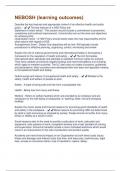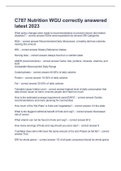NEBOSH (learning outcomes)
Describe the key features and appropriate content of an effective health and safety
policy. - ✔️✔️The key features of a HSE Policy are:
Statement of intent (what) - This section should include a commitment to prevention,
compliance and continual improvement. It should also set out the aims and objectives
for achieving this.
Organisation (who) - A HSE Policy should clearly state who has responsibility and for
what actions with regard to HSE.
Arrangements (how) - Details how objectives will be met. Will typically include
procedures for effective planning, organizing, control, monitoring and review
Explain the role of national governments and international bodies in formulating a
framework for the regulation of health and safety. - ✔️✔️The ILO formulates
international labor standards and attempts to establish minimum rights for workers.
They have created conventions (legally binding) and recommendations (non-binding)
which apply to member countries. The ILO also sets out codes of practice, guidelines
and declarations. Most countries have developed their own laws and regulation relating
to Occupational Health and Safety.
Outline scope and nature of occupational health and safety. - ✔️✔️Relates to the
safety, health and welfare of people at work.
Safety - A state of being safe and free from unacceptable risk.
Health - Being free from injury and illness.
Welfare - Refers to welfare facilities which are provided by an employer and are
necessary for the well-being of employees i.e. washing, toilet, rest and changing
facilities.
Explain the moral, social and financial reasons for promoting good standards of health
and safety in the workplace. - ✔️✔️Moral reasons for promoting HSE are determined
by what is right and wrong as imposed by society. People should not suffer from injury,
illness or fatality as a result of work.
Social reasons refer to the need to provide a safe place of work, safe plant and
equipment, safe systems of work, competent workers and a high standard of training
and supervision. Economic benefits include a more motivated workforce which would
result in an improvement in the rate of production and product quality
Accidents can have financial impact on an Organisation by both direct costs (injury,
illness and damage) and indirect costs (lost time, sick leave pay, overtime pay, legal
fees, excess on insurance claims, loss of reputation, repairs, delay).
, Outline the key elements of a health and safety management system. - ✔️✔️An
effective HSE-MS will generally follow the plan-do-check-act cycle.
Plan - Establishes objectives and processes required to deliver results in accordance
with HSE policy.
Do - Implement the planned processes.
Check - Monitor and measure processes with regard to HSE policy and objectives.
Results should be reported.
Act - Take actions to continually improve HSE performance.
Explain the purpose and importance of setting policy for health and safety. - ✔️✔️A
HSE Policy clearly describes how HSE will be managed within an Organisation and
demonstrates a commitment to a safe working environment. It also sets out the aims
and objectives with regard to improving HSE in the workplace.
.
Outline the organisational health and safety roles and responsibilities of employers,
directors and managers. - ✔️✔️Employers - Provide safe working environment and
protect health, safety and welfare of employees.
Directors - Taking responsibility and ownership of HSE, increasing visibility of directors
in the workplace, ensuring HSE is an agenda item for board meetings, ensuring
adequate resources are allocated.
Managers - Provide connection between strategic apex and operations.
Explain the concept of health and safety culture and its significance in the management
of health and safety in an organisation. - ✔️✔️Health and safety culture is a part of an
organisations' culture. It can be described as the ideas and belief that all members
share with regard to risk, accidents and ill health. Key aspects of HSE culture include
management commitment, visible management, good communication, active employee
participation and effective HSE training.
An effective HSE culture can increase organisational performance and improve health
and safety.
Outline the human factors which influence behaviour at work in a way that can affect
health and safety. - ✔️✔️Organisation - Relates to culture, leadership, resources, work
patterns and communication. Often has the greatest impact on employee behavior in
the workplace. Can be a contributing factor to accidents i.e. high work pressure, poor
communication, lack of planning or procedure.
Job - Task, workload, environment, controls and procedures. Unclear procedures,
poorly maintained equipment and high workload may lead to accidents in the workplace.
Individual - Competence, skills, personality, attitudes, risk perception, motivation. An
accident may be the result of low competence, fatigue, boredom or medical problems
relating to an employee.





